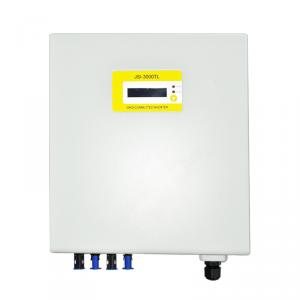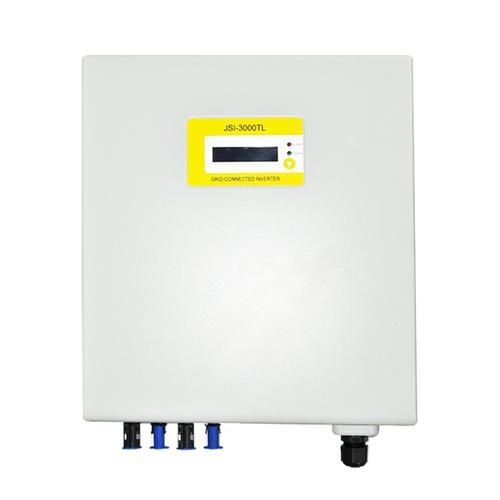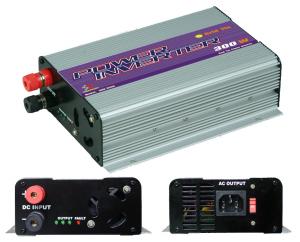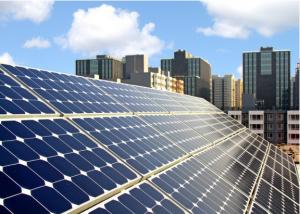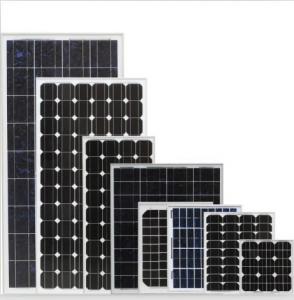Canadian Solar Grid Connected Solar Inverter 3000W
OKorder Service Pledge
Quality Product, Order Online Tracking, Timely Delivery
OKorder Financial Service
Credit Rating, Credit Services, Credit Purchasing
You Might Also Like
Grid connected solar inverter 3000W
◆ Compact size and high power density
◆ High speed MPPT for real time power tracking and improved energy harvesting
◆ Transformerless operation for highest efficiency 97%
◆ High overload capability under most ambient conditions
◆ Certified grid connected operation according to the international standards
◆ True sine wave output
◆ Integrated RS485/RS232 serial communications
◆ Multi-language LCD display
| MODEL | 1100TL | 1500TL | 2000TL | 2500TL | 3000TL | 3600TL | 5000TL | 6000TL |
| Max. DC Input Power(W) | 1200 | 1750 | 2300 | 2700 | 3660 | 3750 | 5300 | 6400 |
| Max DC Voltage(Vdc) | 450 | 450 | 500 | 550 | ||||
| MPPT Operating Range(Vdc) | 60~450 | 100~450 | 100~500 | |||||
| Number of Parallel Inputs | 1 | 2 | 3 | |||||
| Number of MPPT Trackers | 1 | |||||||
| Max. Input Current(A) | 11.7 | 10 | 13 | 14.5 | 20 | 20 | 22.5 | 27.5 |
| Nominal Output Power(W) | 1100 | 1500 | 2000 | 2490 | 3000 | 3600 | 4600 | 6000 |
| Max. Output Power(W) | 1100 | 1650 | 2200 | 2490 | 3400 | 3600 | 5000 | 6000 |
| Nominal Output Current(A) | 4.8 | 6.5 | 8.7 | 10.8 | 13 | 15.7 | 20 | 26 |
| Max. Output Current(A) | 5.7 | 7.9 | 10.5 | 12 | 15.7 | 16 | 24 | 29.3 |
| Nominal AC Output Voltage(Vac) | 230 | |||||||
| AC Output voltage range (Vac)* | 190~265 | |||||||
| AC Grid frequency range (Hz)* | 50±5 | |||||||
| Power Factor (cosφ) | >0.99 | |||||||
| THDI | <3%(at nominal output power) | |||||||
| Max.efficiency | 96.50% | 96.50% | 97.00% | 97.10% | 97.20% | 97.30% | 97.40% | 97.40% |
| Euro.efficiency | 95.40% | 95.50% | 96.20% | 96.30% | 96.40% | 96.60% | 96.80% | 96.80% |
| MPPT. efficiency | 99.60% | 99.60% | 99.60% | 99.60% | 99.60% | 99.60% | 99.60% | 99.60% |
| Operating Temperature(℃) | -25~+60 | |||||||
| Noise typical[dB(A)] | ≤20dB(A) | |||||||
| Operating Consumption(W) | 0 | |||||||
| Electrical Isolation | Transformerless | |||||||
| Cooling Concept | Natural cooling | |||||||
| Protect Level | IP65 | |||||||
| Communication | RS232(WiFi optional) | |||||||
| Dimension (W×D×H)(mm) | 345*152*315 | 345*152*355 | 345*152*385 | 345*152*505 | 345*162*573 | |||
| Weight (Kg) | 12 | 13 | 15 | 19 | 24 | |||
| *AC grid voltage range and frequency range depend on local standards | ||||||||
- Q: What is the role of anti-islanding protection in a solar inverter?
- The role of anti-islanding protection in a solar inverter is to ensure the safety of utility workers and prevent damage to the electrical grid in the event of a power outage. It detects when the grid goes down and immediately shuts off the solar inverter, preventing it from continuing to generate electricity and potentially sending power back into the grid. This feature is essential to avoid the risk of electricity flowing into the grid, which could pose a danger to technicians working on power lines and disrupt the stability of the electrical system.
- Q: How do you choose the right size of solar inverter for a solar power system?
- When choosing the right size of solar inverter for a solar power system, it is important to consider the maximum power output of your solar panels. The inverter should have a capacity that matches or slightly exceeds the maximum power output of the panels to ensure optimal performance. Additionally, the inverter's voltage and current ratings should be compatible with the solar panels and other system components. Consulting with a solar professional or installer can help determine the appropriate size of inverter based on your specific system requirements.
- Q: Can a solar inverter be used in harsh environmental conditions?
- A solar inverter is capable of operating in harsh environmental conditions. It can withstand a wide range of environmental factors, including extreme temperatures, humidity, dust, and vibrations. Manufacturers often construct solar inverters using durable materials and apply protective coatings to shield them from severe weather conditions. Furthermore, many solar inverters are equipped with advanced cooling mechanisms to prevent overheating in hot climates. Nevertheless, it is crucial to consider that the durability and performance of a solar inverter in harsh conditions may differ depending on the brand and model. To guarantee optimal performance and longevity, it is advised to select a reliable and high-quality solar inverter specifically designed for use in harsh environmental conditions.
- Q: Can a solar inverter be used in areas with high dust and dirt accumulation?
- Yes, a solar inverter can be used in areas with high dust and dirt accumulation. However, it is important to regularly clean and maintain the inverter to prevent any performance issues caused by the accumulation of dust and dirt.
- Q: What is the role of a power management system in a solar inverter?
- The role of a power management system in a solar inverter is to optimize the generation, distribution, and usage of solar power. It ensures efficient energy conversion, monitors the solar panel performance, manages the flow of electricity to and from the grid, and maximizes the overall system efficiency. Additionally, it may include features such as power factor correction, voltage regulation, and protection mechanisms to enhance the reliability and safety of the solar inverter.
- Q: How does the temperature affect the performance of a solar inverter?
- The temperature affects the performance of a solar inverter by impacting its efficiency and power output. High temperatures can cause the inverter to overheat, leading to a decrease in its efficiency and overall performance. This can result in reduced power generation and potential damage to the inverter. Conversely, lower temperatures can enhance the inverter's efficiency and power output, allowing it to perform optimally. Therefore, maintaining suitable operating temperatures is crucial for maximizing the performance and longevity of a solar inverter.
- Q: How does a solar inverter protect against overvoltage or overcurrent?
- A solar inverter protects against overvoltage or overcurrent by continuously monitoring the electrical output from the solar panels. If the voltage or current exceeds the safe operating limits, the inverter automatically adjusts the output or shuts down to prevent damage to the system. It achieves this through built-in protective mechanisms such as surge protectors, voltage regulators, and circuit breakers.
- Q: What are the main components of a solar inverter?
- The main components of a solar inverter typically include the DC input, MPPT (Maximum Power Point Tracking) system, inverter circuit, transformer, and AC output.
- Q: Can a solar inverter work in low light conditions?
- Yes, a solar inverter can work in low light conditions. While the output power of a solar inverter may decrease in low light conditions, it is still capable of converting the available sunlight into usable electricity. The performance may vary depending on the specific model and technology used, but modern solar inverters are designed to work efficiently even in low light situations.
- Q: Can a solar inverter be repaired or replaced if it malfunctions?
- Yes, a solar inverter can be repaired or replaced if it malfunctions. In many cases, minor issues can be fixed through repairs, such as replacing faulty components or updating firmware. However, if the inverter is extensively damaged or beyond repair, it may need to be replaced with a new one. Ultimately, the course of action will depend on the severity of the malfunction and the expertise of the technician assessing the situation.
Send your message to us
Canadian Solar Grid Connected Solar Inverter 3000W
OKorder Service Pledge
Quality Product, Order Online Tracking, Timely Delivery
OKorder Financial Service
Credit Rating, Credit Services, Credit Purchasing
Similar products
Hot products
Hot Searches
Related keywords
